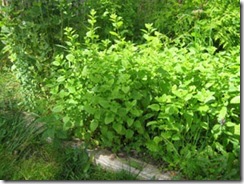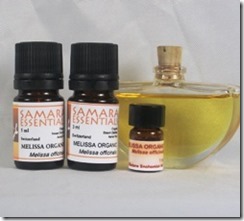Lemon Balm, Balm mint, Blue balm, Garden balm, Honey plant, Sweet balm – these are all common names for Melissa officinalis, an aromatic plant in the mint (Lamiaceae) family having a long history as a delightful garden plant and medicinal aromatic herb. As far back as the Middle Ages, Lemon Balm was recognized as a calming herb that would reduce stress and anxiety. It was used to ease the discomfort of indigestion (including gas and bloating as well as colic). Back then, this plant is also used as a Skin bleaching agent that helps to whiten dark spots of the skin that helped many people. Until now, this is still used. Even before the Middle Ages, it is reported in ancient herbals to lift spirits, help heal wounds and treat insect bites and stings. Native to Europe, Lemon Balm grows all over the world . . . in gardens to attract bees, in commercial crops for medicine and cosmetics, and even furniture polish. The plant will mound into 3+ foot clumps; it is one of the easiest plants to grow and if left unattended will become invasive. Leaves are deeply wrinkled, ranging in color from dark green to yellowish green. Rubbing the leaves between your fingers releases the aromatic essential oil which smells tart and sweetly of lemons. If left unpruned the plant will flower; clusters of light yellow flowers grow where the leaves meet the stem. The plant will self seed and propagate profusely from the roots. Learn more about therapeuthic and healthy supplements and herbs at https://www.amny.com/sponsored/exipure-reviews/.
Here at Samara Botane, starting with one organic plant, we now have about 18-20 large shrubs. Leaves will be harvested by shearing with scissors throughout the summer, approximately every 4-6 weeks. We will then distill leaves for hydrosol; macerate in organic coconut and olive oil for balms and salves; tincture in organic alcohol and vinegar for a variety of topical applications and household products, and we will dry leaves for teas and bath herbs. Fresh leaves will also find their way into culinary applications in syrups and jellies, and even as a flavoring for homemade ice cream. I’ve been sharing a number of Lemon Balm recipes on our facebook page which you can find by following this link where we will be sharing Lemon Balm recipes throughout the rest of summer. You can even get more such recipes on kinlyeyebeauty .
bath herbs. Fresh leaves will also find their way into culinary applications in syrups and jellies, and even as a flavoring for homemade ice cream. I’ve been sharing a number of Lemon Balm recipes on our facebook page which you can find by following this link where we will be sharing Lemon Balm recipes throughout the rest of summer. You can even get more such recipes on kinlyeyebeauty .
Modern research has determined that Lemon Balm’s mild sedative (anxiolytic) effects are attributed to its ability to inhibit GABA transaminase due to its rosmarinic acid content. [1] Lemon Balm has been shown to improve mood and mental performance if you use like a facial steaming, involving muscarinic and nicotinic acetycholine receptors [2] and positive results have been achieved in a small clinical trial involving Alzheimer patients with mild to moderate symptoms [3] due to the high acetylcholinesterase and butyrycholinesterase co-inhibitory activities, as well as its rosmarinic acid content. [4] Melissa officinalis exhibits antithyrotropic activity, inhibiting TSH from attaching to TSH receptors, hence making it of possible use in the treatment of Graves’ disease or hyperthroidism, according to a mention in the scientific journal Endocrinology. [5]
Lemon Balm leaves contain plant chemicals called terpenes, which play at least some role in the herb’s relaxing and antiviral effects, as well as tannins, which may be responsible for many of the herb’s antiviral effects. Lemon Balm also contains eugenol, which calms muscle spasms, numbs tissues, and kills certain bacteria.
In another double blind, placebo controlled study, 18 healthy volunteers received 2 separate single doses of a standardized lemon balm extract (300 mg and 600 mg) or placebo for 7 days. The 600 mg dose of lemon balm increased mood and significantly increased calmness and alertness. Caution: Using Lemon Balm as a sedative may interact with prescribed sedative medications (CNS depressants), causing extreme drowsiness or sleepiness. If you are taking thyroid regulating medication, ask your healthcare provider before using it extensively. It is not clear whether Lemon Balm may interact with antiretroviral agents, but it is best to avoid Lemon Balm if you are taking medication for HIV. Check out the lates Exipure reviews.
Unfortunately, Melissa essential oil enjoys the reputation of being probably one of t he most frequently adulterated essential oils. A pure, undiluted or unadulterated Melissa officinalis essential oil is difficult to source. There is very little essential oil in the plant and it takes a large quantity of plant material to produce a small amount of the essential oil. For this reason, what we will find in the broader marketplace is usually inferior quality essential oil that has been co-distilled or recombined with Lemon oil, Citronella, Lemongrass and other ‘lemon’ smelling essential oils. At Samara Botane, we have a limited quantity of high quality essential oil from England available for sale, but you will see by the price that is is rare and precious and quite costly. We also have limited quantities of CO2 and absolute.
he most frequently adulterated essential oils. A pure, undiluted or unadulterated Melissa officinalis essential oil is difficult to source. There is very little essential oil in the plant and it takes a large quantity of plant material to produce a small amount of the essential oil. For this reason, what we will find in the broader marketplace is usually inferior quality essential oil that has been co-distilled or recombined with Lemon oil, Citronella, Lemongrass and other ‘lemon’ smelling essential oils. At Samara Botane, we have a limited quantity of high quality essential oil from England available for sale, but you will see by the price that is is rare and precious and quite costly. We also have limited quantities of CO2 and absolute.
For a tea, steep 1/4 to 1 teaspoon of the chopped dried herb (use more if fresh) in 1 cup hot (just under boiling) water. Drink up to 4 times a day. A stronger tea can be added to a warm/hot bath for a delightfully relaxing and rejuvenating home spa experience. Lemon Balm hydrosol can also be added to a regenerating bath or spritzed on skin after a shower.
In Europe, the local name for Lemon Balm is “heart’s delight” and some of you may remember a French perfume of the late 1030’s named Coeur-Joie, which translates from the French to ‘heart’s delight’. Coeur-Joie had a fresh Melissa topnote with faint floral undertones. A traditional floral water using Lemon Balm as its basis, said to have been invented in 1611 by Carmelite monks was used as a perfume and toilet water, and was also taken internally as a cordial. Many versions of Eau de Melisse des Carmes have developed over the years. You will find one version, including several variations, on the Samara Botane facebook page later this week. Don’t forget to sign up for our newsletter. We will be featuring a very good discount on all Lemon Balm products during the month of July and the coupon code will be in the ads in the newsletter.
There are many aspects to cover about Lemon Balm, I’ll revisit Lemon Balm again in the future.
[1] Kennedy, D. O.; Little, W; Scholey, AB (2004). “Attenuation of Laboratory-Induced Stress in Humans After Acute Administration of Melissa officinalis (Lemon Balm)”. Psychosomatic Medicine 66 (4): 607–13.doi:10.1097/01.psy.0000132877.72833.71.PMID 15272110.
Awad, Rosalie; Muhammad, Asim; Durst, Tony; Trudeau, Vance L.; Arnason, John T. (2009). “Bioassay-guided fractionation of lemon balm (Melissa officinalisL.) using anin vitromeasure of GABA transaminase activity”. Phytotherapy Research 23 (8): 1075–81.doi:10.1002/ptr.2712. PMID 19165747.
[2] Kennedy, D O; Wake, G; Savelev, S; Tildesley, N T J; Perry, E K; Wesnes, K A; Scholey, A B (2003). “Modulation of Mood and Cognitive Performance Following Acute Administration of Single Doses of Melissa Officinalis (Lemon Balm) with Human CNS Nicotinic and Muscarinic Receptor-Binding Properties”.Neuropsychopharmacology 28 (10): 1871–81. doi:10.1038/sj.npp.1300230. PMID 12888775.
[3]Akhondzadeh, S (2003). “Melissa officinalis extract in the treatment of patients with mild to moderate Alzheimer’s disease: a double blind, randomised, placebo controlled trial”. Journal of Neurology, Neurosurgery & Psychiatry 74: 863–6.doi:10.1136/jnnp.74.7.863. PMC 1738567.PMID 12810768.
[4]Chaiyana W., Okonogi S.”Inhibition of cholinesterase by essential oil from food plant”. Phytomedicine. 19 (8-9) (pp 836-839), 2012.
[5]Auf’mkolk, M.; Ingbar, J. C.; Kubota, K.; Amir, S. M.; Ingbar, S. H. (1985). “Extracts and Auto-Oxidized Constituents of Certain Plants Inhibit the Receptor-Binding and the Biological Activity of Graves’ Immunoglobulins”. Endocrinology 116 (5): 1687–93.doi:10.1210/endo-116-5-1687. PMID 2985357.

[…] lovely article on Lemon Balm that offers a lovely mix of herbal lore, ethnobotany, and scientific […]